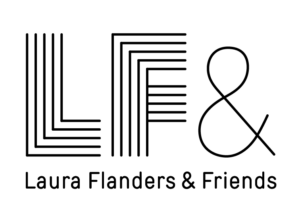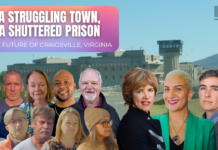What if judges could know a person more completely before sentencing them to prison? An organization called Complete Picture uses the power of film and storytelling to give judges an in-depth, humanizing look at the lives of defendants facing prison for non-violent crimes. All of Complete Picture’s films have resulted in a sentence reduction and half of their clients received no prison time at all. In this episode, Laura speaks with the project’s founding filmmakers, whose own experience of incarceration inspired the project. She interviews a defense attorney who’s seen the impact on judges and talks with two defendants about how these video portraits changed their lives—and not just in the courtroom. Could films like theirs help transform the justice system across the country? Find out how in this episode.
Guests
- Rebecca Grace, Founder & CEO, Complete Picture
- John Gray, Executive Director & Marketing Director, Complete Picture
- Gary Roberts, Mechanic & Defendant
- Chondra, Caregiver and Current Defendant
To listen to the uncut interviews, and to get episode notes for this episode and more, become a Patreon partner here.
Prefer to Listen?
Transcript
THE LAURA FLANDERS SHOW
THESE FILMS KEEP PEOPLE OUT OF PRISON
LAURA FLANDERS: An individual, a person, facing prison time may also simultaneously be a dedicated parent, a valued employee, a huge asset to their community. Though it may sound obvious that a person is more than a crime they’ve committed, the U.S. justice system doesn’t typically function as if this were actually the case. Millions of people are in jail for nonviolent offenses. Many of which amount to little more than possession of drugs, parole violations or misdemeanors. Add racial bias, gender and economic disadvantage, what if judges could see a whole person before they sentenced them? Would we turn away? Would they turn away from endless incarceration, from punishment generally? An organization called Complete Picture uses the power of film and storytelling to give judges exactly that, a complete picture, an in depth humanizing portrait, a look at the lives of individuals facing prison for nonviolent offenses. Complete Picture has helped reduce or prevent prison time for every single defendant it has ever worked with. And the organization’s founders say, this is just the beginning, films like theirs could become a regular part of the sentencing process across the country today. There’s even funding, if only people knew about it. Today it’s art that’s changing lives and healing systems, one person at a time. Joining me are Complete Picture Founder and CEO, Rebecca Grace, and art director John Gray, partners in life and work. Two of the defendants that they’ve worked with, Gary Roberts and Chondra, who’s asked that we not use her last name. Later I also speak with defense attorney, Shari Rusk, who brought Rebecca and John their very first sentencing mitigation video project. Rebecca, John, Gary, Chondra, welcome to the program, so glad to have you. Let’s start Rebecca with you, I mean, there’s a lot wrong with our so-called justice system and I’m not sure it actually can be healed even one person at a time. But let’s talk about the problem that the Complete Picture, your project, seeks to address.
REBECCA GRACE: One of the key issues is that judges just aren’t given the information they need to make a fair decision about the rest of someone’s life. One of the greatest misconceptions about the criminal justice system in our country is that by being assigned a public defender that automatically ensures due process and fair representation and an equitable outcome. And that is just not the case because public defenders are overburdened and under-resourced. We come at this from a very personal experience. And when John, my husband, was facing prison for a non-violent drug offense, because he had struggled with crack cocaine addiction for 10 years and he needed rehab. And instead of getting rehab for a non-violent drug related crime, he was given prison and where, that didn’t include any rehabilitation. In fact, when he got out, he went straight back to crack until he eventually recovered. But he was given about two and a half minutes to talk to his public defender, and that is common. We decided that we wanted to make a difference and to try to influence that system.
LAURA FLANDERS: Well let me ask you, John, I mean, you’re the art director of this project. Anything you want to add about your personal story and about what you’ve done with Complete Picture that isn’t normal, even by mitigation video standards.
JOHN GRAY: There was a lot of work putting the whole thing together, but it was definitely something we both felt was a calling that we needed to address. And the more we got into it, the more we realized just how many people were in need of having their story told. When I was facing my prison sentence of three years, the public defender came to me and said, “Okay, what do you wanna plead, how’re you gonna plead?” And I thought, well, yes, okay, yes, I’m guilty. And he goes, “Okay, great.” And I said, well, can I talk? And he goes, “What do you want to talk about?” And I said, well, you know, I – I’m not sure what I’m going to be facing. And he said, “Oh my god.” And he slams his docket down on me, or on the table, and he walked off. He comes back a minute later and he goes, “So are you gonna plead guilty or not?” And I said, yes, I’m gonna plead guilty. “Okay great.” He gets up, and he leaves. That was my defense. But not every public defender is like that.
REBECCA GRACE: Right.
JOHN GRAY: That was just, he was a really bad one.
REBECCA GRACE: In fact, the public defenders we work with, the fact that they’ve gone out and sought a sentencing video with their client, says a lot already.
LAURA FLANDERS: I want people to see one of the videos that you’ve made. Gary, what we’re gonna show is a portion of your video. Do you want to just sort of introduce it for us? Like how did you connect to this project?
GARY ROBERTS: I was facing some pretty serious drug charges also. Non-violent also, I’ve been a 30 year methamphetamine addict. Like most addicts, I lost along the way the things most addicts lose, families. My family members became distant, I isolated myself, I lost jobs, I lost homes. I had bad relationships, you know, and the progression of my disease just consumed me. All I wanted to do was use drugs. So when I ended up getting arrested, in the federal court system, it was a really, really scary experience for me. I don’t think that the judge would have saw me in the same light that the film that Rebecca and John did for me, that showed the judge my true self.
LAURA FLANDERS: Take a look at the video, the Complete Picture of Gary.
JOSHUA ROBERTS: One of my favorite things about my dad is how caring he is. He will go out of his way to help people with cars and do mechanic work, he’s worked for hours for free.
STEVE SMITH: Gary has worked for me for close to two years, and I would be almost out of business if I didn’t have him.
LORI JACKSON: I’m a therapist, and Gary came to me almost three years ago in October 2017 after getting out of rehab and getting arrested.
GARY ROBERTS: My getting arrested was, it saved my life is what it did because I got an opportunity to get clean.
LORI JACKSON: My original assessment of Gary when he first came in was that he was a meth addict and it seemed he did illegal things to maintain his habit.
GARY ROBERTS: The court allowed me to go to WellSpace Residential for a 90 day treatment program. That was a deciding moment in my recovery.
LORI JACKSON: As part of Gary’s recovery, he looked at his childhood.
GARY ROBERTS: Growing up I had a real loving family, although there was some alcohol issues.
LORI JACKSON: He made some correlations between his alcoholic home and growing up thinking substance abuse was a part of life.
JOSHUA ROBERTS: I did not see any change coming. I kind of thought the road that he was on was where he was gonna end up going for the rest of his life, and didn’t really know how long that would be.
GARY ROBERTS: I managed to put together three years clean and sober. I haven’t put a thing in my body to change the way I feel.
DERRICK CASTRO: We run an addiction recovery program for our church.
JAMIE CASTRO: And we’ve known Gary for three years. He wanted to give up anything that alters your perception.
GARY ROBERTS: I know the path I’m on now is the right one for me. It’s given me back relationships with my family, it’s given me a place in society, I found a spot in the LDS church. I mean, I can go on and on and on. You know, I love my NA meetings.
JAMIE CASTRO: Right now he has his feet on the ground and he is headed in absolutely the right direction in reestablishing healthy relationships with his family and friends.
GARY ROBERTS: You know, I started seeing a future. I started seeing things could change, because for a long time, I didn’t think they could. Three years is not a long time, but it’s a start, it’s a foundation. You know, this has been a journey of self discovery. And although I haven’t learned everything in recovery because it’s a lifelong process. Every day I get to learn something new if I remain teachable. This isn’t the end of the road, just the beginning.
LAURA FLANDERS: Gary, back to you. What was it like when you saw that for the very first time?
GARY ROBERTS: My son, my employer, people from my church had just had — they could see things in me that I had, that I couldn’t see in myself. Rebecca and John just did an outstanding job of putting me in a different light, so the judge could see that, and it had a positive effect, you know. I was looking at from five to 40 years for drug trafficking charges, and before I left the courtroom, the judge had just given me a time sure sentence and five years probation. And he also told me that he had never departed a sentence like this before, but he saw things in me that he was willing to take a chance on. And it just, it was just remarkable.
LAURA FLANDERS: Chondra you’re listening to all this and your sentencing is still pending. Can you tell us what you expect or you hope a complete picture in your case will do come sentencing?
CHONDRA: I’m hoping that the video will make the judge see that 10 to 20 years without me here would be very detrimental to not just me and my family, but to a lot of people. A lot can be accomplished in 10 to 20 years that you cannot accomplish from a jail cell. You know, when we think about prison, and we’re so quick to just send people away, send them away, send them away, and then when we get them back, you don’t want to, you don’t want them there. We’re not healing. We’re not healing America. We are actually not even putting a bandaid on it, but we’re making and creating a worse situation and a place where people won’t want to be, or to live, it makes you want to be a better person, but it makes you want to help other people so that people don’t go through the same things that you go through. Just every day, if you do something positive, it corrects what you have done wrong. It’s all about how you heal yourself and how you heal the people around you.
LAURA FLANDERS: Rebecca, what have you learned about Chondra in this process and what are you doing behind the camera, that also makes a difference in this world that we’re operating in? ‘Cause that’s an interesting part of this story too. It’s not just about the final product, the film itself.
REBECCA GRACE: So 60 to 70% of women who are incarcerated, experienced severe childhood abuse, which Chondra went through abuse for many, many, many years as a little girl. 60 to 70% of women who are incarcerated also have experienced domestic abuse with a partner, an intimate partner, and that’s something that Chondra also lived through for seven years. Prison is really not a place to help a person to learn to change criminogenic thought patterns and belief systems. The one single greatest way to help keep a person out of prison is to give them opportunities to get higher education, which is something that Chondra’s doing. She’s just gotten her CNA license and she’s doing really well. So she can earn more money and be more self-sufficient because she’s a single mother of four boys —
JOHN GRAY: A phenomenal mother.
REBECCA GRACE: And she’s a phenomenal mother.
JOHN GRAY: She is.
REBECCA GRACE: All of her boys are at home —
JOHN GRAY: A heart of gold.
REBECCA GRACE: And they love her. And they’re good boys because she’s really a nurturing parent. And so that’s another thing that we want to let the judge understand is the value that Chondra brings to her children, and to her family, and to her greater community.
LAURA FLANDERS: There may be people watching this who think, well, doesn’t the judge, don’t the defense attorneys communicate all this, doesn’t the judge have some sense of this statistics around trauma, and gender, and race, and violence, and you name it. Surely they know some of this. Well, we spoke with a defense attorney, Shari Rusk, who was one of the first people that you got involved with in this project, about what people like herself even, and certainly judges bring to that sentencing moment, in terms of preconceived ideas, or even just any idea of the person that they’re sentencing. Here’s what she had to say.
SHARI RUSK: I’m Shari Rusk, I’m a criminal defense attorney focusing on federal criminal cases almost exclusively.
LAURA FLANDERS: What’s the situation that you find yourself in, your clients find yourself in, vis-a-vis what the sentencing judge does or doesn’t know.
SHARI RUSK: So when I’m appearing before a federal sentencing judge, the extent of their knowledge, when it comes to sentencing, is that my client was charged with a crime and convicted of a crime. So they see an indictment, they see a set of charges, and the worst mistake my clients ever made in their life is the sum total of their existence to that federal judge. So there’s no depth, there’s no personality, there’s no uniqueness. And to, to amplify that, to make matters worse, when probation does a report, as they do in every federal case, they’ll do the person’s criminal history back to juvenile records, everything they’ve ever been in trouble for, they’ll focus on the worst aspects of the particular crime the client is charged with. And essentially it’s not just negative, it’s negative through a microscope with no countervailing perspective. There’s nothing about what the client has suffered or what they’ve achieved. And that’s where somebody like Rebecca comes in, to try to supply that to the court, who’s gonna make a decision about the rest of the person’s life.
LAURA FLANDERS: There’s pressure on the defendant too, I mean, maybe not from you, but many defendants find themselves under tremendous pressure to, as they say, cop a plea, to plead guilty and to accept plea deals, that don’t have a lot of flexibility in them when it comes to sentencing.
SHARI RUSK: The pressure is crushing. We have clients facing, you know, plea offers of five years when they’re facing a mandatory minimum 20 and they have families. So I’ve had innocent clients say, I would rather take the deal than take the risk. You know, the risk is so perilous, you know, I just, I can’t afford to do it. So, and when you, when you get into the details, as Rebecca does in Complete Picture it, it is so moving. You know, someone might be in desperate financial circumstances with nowhere else to turn, they get co-op, co-opted back into doing some, you know, some drug deal and that’s it, you know, that’s a 10 year mandatory minimum. And it’s, the circumstances are really appalling. The system itself needs radical change. I mean, that’s part of the problem. All of the things that you see elsewhere, like systemic racism, you know, misogyny, things that are built into the fabric of the system, are hyper drive in criminal justice. It just, you know, militates against individuals. And so yes, the sentencing video deals with it on an individual level, but systemic change is really what’s needed. I think if there was a greater understanding, I find myself, you know, I can be on an airplane sitting next to someone who asks me, how do you do that for a living? How do you represent these people? That’s the first reaction. And after a 20 minute conversation, it’s like night and day, ah, I see, you know, that’s what it’s about. You know it’s a real eye-opener.
LAURA FLANDERS: Shari talked there about the pressure that everybody in this system is under, from the defense attorneys, to the judges, to the, even the prosecutors. Can you talk about that from your point of view and your goals with respect to the systemic challenges that our so-called criminal justice system faces?
REBECCA GRACE: Unfortunately, our criminal justice system is a serial abuser, really, of the poor, the people who are disabled, people who suffer from mental health illness, and substance use disorder. As I’m trying to scale Complete Picture up, it’s one of the criticisms I get is, well these videos are too expensive, you have to do them quicker, you have to do them for less. And I’m like, no, I’m not gonna make that mistake. I’m not going to do, what’s already being done wrong in the system, which is, you know, devaluing a person’s right to have their story, full story told and to have due process. That’s what we’re doing differently. Complete Picture is redefining what due process and fair representation looks like.
LAURA FLANDERS: There is money for this in the system. If it’s there, why don’t we see more of these videos getting made?
REBECCA GRACE: Many times the, when the judge, when an attorney applies for funding and asks the judge for funding for our videos, the judge will just turn it down. So there’s some skepticism that we’re facing whenever you’re trying to introduce something new, right? But the interesting thing is, once a judge just approves funding for one of our videos, they will approve it from then on, because that judge realizes that it’s a tool. They watched the video and they’re like, oh my gosh, I wouldn’t have understood this.
LAURA FLANDERS: Coming back to you, Chondra. What difference has it made to you to know that when the judge is making the sentencing decision in your case, they will be doing that having seen, ideally, having seen this video, having a much better understanding of who you are, and who you are to the people in your community?
CHONDRA: The way I feel about it is the judge is seeing me and seeing me for who I am, and at least knows that it is a better side to Chondra. There is not just what you’re seeing on this paper. There is a woman who has a voice, who has people who love her, and they want to see her succeed and not be in prison. So I feel that the video is, it’s helped, it’s a helping hand in a reality where there is no helping hand. And so that is why I’m so grateful for Rebecca and her husband and everyone who has helped me through this very difficult time.
LAURA FLANDERS: Rebecca, coming back to you. Two things, one, I do want you to talk a little bit about what you’re doing behind the camera, in the making of these films that is also interesting and an interesting part of this project. And then secondly, I know that you mentioned scaling up? What does that look like for the Complete Project and where are you in that process?
REBECCA GRACE: So when we set out to make a sentencing video, we don’t cut any corners. These pieces that we’re making are incredible works of art. They’re not quick, you know, flybys that we do in one or two days, we go to the defendant’s house and we interview them for several, two to three days, we interview four members of their community, and four members of their family, so that we get a really good, not only a very personal perspective of who they are from their family, but how they integrate and help and give back to their community. And what we find is that during the time that we’re filming, 100% of the time, the defendant sits in the side room and cries, because like Gary was saying, it’s probably the first time that, A, many of their past traumas and struggles have been validated by their loved ones, but also that they’re hearing, there’s so much shame involved in having committed a crime, and so much remorse. A person can’t just walk around with shame all the time and heal, and to be, this very experience of hearing why they’re loved and why they’re valued for two days straight in itself, helps that person shift and start a new chapter in their lives. I believe that it’s, that alone is a helpful ritual. So then we spend about 14 or 15 days for each project and editorial, and we go back and forth in submitting different versions of the film to the defense attorney. And then the defense attorney will submit a link to the judge. So all this work happens for one, an audience of one.
JOHN GRAY: One person, the judge.
REBECCA GRACE: Right? And the judge will watch the video. Sometimes the defense attorneys are opening the door to share it with probation because in the system, the probation department has a lot of power. People don’t know this, but the probation department will recommend a sentence to the judge. And oftentimes the judge just takes that and runs with it. So the defense attorneys are getting out in front of it and they’re submitting it to the probation department. They’ll submit it to the prosecutor. And we’ve had situations where even the prosecutor has decided to change the recommended sentence for a person.
JOHN GRAY: But as far as expanding, we do want to expand into other states, other cities. So, create satellites of what the Complete Picture does in other places that are also with courts and judges and that whole thing.
REBECCA GRACE: Yeah, when we started this, it was just an experiment. And we, once John and I came home from a shoot one day and realized, this is amazing, like this is powerful, we decided to create a model because the doors aren’t just opening up, like judges aren’t just approving any funding. Our society is still focused on punitive forms of social control rather than preventative. Statistics show that mental health illness increases a year after being in prison. So we have more than 50% of people in our prisons and jails have been diagnosed with a mental illness and almost 50% of people who are in federal prison are there for drug related crimes. So they’re suffering from drug addiction.
JOHN GRAY: And it also fosters recidivism as well.
REBECCA GRACE: That’s right. I mean it creates this whole host of problems, not only for the individual, but for their family, like Chondra will leave behind a ten-year-old son and there’s no good place for him to go.
JOHN GRAY: Foster care, that’s where he’ll go.
REBECCA GRACE: And she’ll also leave behind a son who has autism and who she cares for on a day-to-day basis. And he might need to be institutionalized, Chondra and I talked about that. Gary coming through for his children, he just put the down payment down. He saved all of his money and he worked hard and he bought his son a home. So he’s able to show up for his children and his family in the way that he’d wanted to his whole life.
LAURA FLANDERS: Gary, do you want to talk about that?
JOHN GRAY: Yeah, it wasn’t that I put the down payment down, but I helped them with the security deposit, which was something that I never could do before. I did have an opportunity because of gainful employment now, to set aside some money. And I couldn’t think of a better way to spend it than to help my son realize the American dream, you know, something that I never was able to do. I’ve always rented all my life. I just, because of my addiction, you know, it wasn’t something that I thought about. I’m super, super grateful today to be able to do those kinds of things.
LAURA FLANDERS: Thank you so very much for giving us a very Complete Picture, and Chondra, Gary, both, congratulations on getting to where you are in your lives. I hope that you get the chances that you deserve. I’ll be back in just a minute with some closing comments.
The Complete Picture, there are so many takeaways from today’s conversation that I don’t know where to start. For one thing, what if we told the people we cared about just what we thought of them more often and not just the bad stuff either, but also the good. Secondly, how about we do the same for ourselves? Take a moment to pause and consider the complete picture of the context in which we live. What is it that makes us do the things we do and feel the way we do? Maybe that’s just what workers have done in this forced pause of the pandemic. They’ve gotten a bit of a sense of the duress they’ve been experiencing at work, the unsafe conditions, the culture, and just how hard it’s been. Maybe they actually want something else. In this season, around Labor Day, as employers are bemoaning the lack of workers and talking about how hard it is to fill some vacant spots. It’s clearly not just about extended and increased unemployment benefits. The states that have cut those off early, haven’t seen the massive return to work that they expected. No, there are bigger, deeper questions being asked about our culture and the safety of our workplaces. From home health situations to manufacturing, and one Ohio employer told the Wall Street Journal this month that he realizes now he had rested for too long on the recession. He said he’d milked that recession for one or two years too long, to suppress wages and to reduce improvements in the workplace. He says he’s seen the error of his ways. He’s increased wages for his staff, and guess what? He’s not having a problem filling spots and he’s retaining workers longer, and they’re happier to boot. So if we had a more complete picture, maybe we’d make some different choices. Have we gotten that complete picture, yeah? I’m Laura Flanders, for “The Laura Flanders Show”, till the next time, stay kind, stay curious, and thanks for joining me.
For more on this episode and other forward thinking content and to tune into our podcast, visit our website at LauraFlanders.org and follow us on social media at @TheLFshow.
Want More Politics and Society Coverage?
You can find more LF Show coverage here.
Accessibility
The Laura Flanders Show is committed to making our programming, website and social media as accessible as possible to everyone, including those with visual, hearing, cognitive and motor impairments. We’re constantly working towards improving the accessibility of our content to ensure we provide equal access to all. If you would like to request accessibility-related assistance, report any accessibility problems, or request any information in accessible alternative formats, please contact us.
















